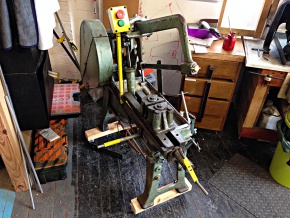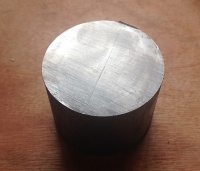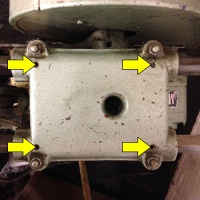Power Hacksaw
 | |
| Equipment Information | |
|---|---|
| Status | Unknown |
| Manufacturer | Rapidor |
| Model | Unknown |
| Hackspace Information | |
| Induction Required | No |
| Card RFID Enabled | No |
| Owner | Aidan |
The Basics
This Rapidor Power Hacksaw, or donkey saw, is for those times when you really don't want to cut through a thick chunk of steel using a manual hacksaw. Cutting with this machine instead is slow, but effort free and relatively precise. It is mounted on castors to allow easy repositioning, but keep in mind that it is still very heavy!
An adjustable end-stop allows for reasonably precise repeated cuts and is adjusted from both sides of the machine body.
It is for cutting both ferrous and non-ferrous metals as well as plastic. Wood is better suited elsewhere because it will soak up the grease and oil that this machine spreads everywhere.
Please clean up the swarf created after you have finished cutting - wiping out the tray now is much easier than chipping it off in a few months time!
Safety
The blade body will not protrude past the yellow section of the vise handle.
- Keep away from the moving blade body, especially when starting.
- Do not press down on the blade body to make it cut faster.
- Do not reach underneath the propped blade body.
- Do not remove the safety covers.
- Keep fingers clear of pinch points.
- Stop the machine before making adjustments.
- Cut metal will be hot.
- Ensure the castors are locked before you start the blade moving!
Making a cut

If you are unsure how to use this machine, please ask someone who does.
- Select the appropriate tooth blade and fit it (see below).
- Secure your work-piece in the jaws of the vise and tighten securely.
- Plug in the saw (orange cable) and wait a few seconds for the VFD to boot up.
- Ensure the E-stop button is not pressed in (rotate clockwise to unlock if it is).
- Making sure that you are not in the way of the blade body press the green start button.
- There is a two second delay to starting - this gives you ample time to get out of the way.
- The machine will turn itself off when the cut is completed.
- If you need to stop it early press the red stop button.
Replacing & changing the blade
You may need to change the blade if it breaks or you are cutting thinner/thicker material. It is held in place by 3/16" hex bolts on the blade body. You might need to tighten or loosen the yellow nut (with roll pin) on the end. A good rule of thumb is this: the thinner the work you are cutting, the more teeth you need.
| Material Thickness | ||
|---|---|---|
| TPI | Metric | Imperial |
| 18 | Up to 13 mm | Up to 1/2" |
| 14 | 6 mm - 19 mm | 1/4" - 3/4" |
| 10 | 8 mm - 25 mm | 5/16" - 1" |
| 6 | 13 mm - 38 mm | 1/2" - 1 1/2" |
| 4 | Over 19 mm | Over 3/4" |
- Blades are 14" long, 1.25" high.
- Thickness (kerf) is typically 1.5 mm.
- Spare/different blades are kept on the wall behind the saw, next to the safety equipment.
Replacement blades are available from a variety of places, including Cromwell Tools.
- KEN0405200K - 14"x1.1/4"x6TPI HSS ALL HARD HACKSAW BLADES
- KEN0405230K - 14"x1.1/4"x14TPI HSS ALLHARD HACKSAW BLADES
- KEN0405220K - 14"x1.1/4"x10TPI HSS ALLHARD HACKSAW BLADES
Lubrication

DO NOT drip oil onto the VFD/power supply near the rear of the machine, next to the motor. If you do, definitely don't turn it on.
There are four oil points on the top of the saw body which lubricate the guide rails. Place a drop of oil into each of these holes each time you use the saw to keep it running smoothly. Through the large centre hole there is access to the cam lubrication point which should be oiled regularly.
Finally, there is an oil point on each axle bearing.
There is a cam operated coolant pump built in to the saw which, when used, will prolong the life of the blades. Take note of where the coolant line is pointing (and adjust if necessary) before you turn the saw on!
We are currently looking into the best lubricant to use with this pump for the most common cutting situations.
Risk assessment for use of Powered hacksaw.
Hazards.
- 1) Clothes becoming entangled.
- 2) Wood dust inhalation.
- 3) Blade breaks and causes projectile injury
- 4) Loss of fingers.
- 5) Damage to eyes from particles
- 6) Struck by moving blade
- 7) Burn
Persons at risk.
- Operator.
- Persons nearby.
Initial assessment of risk.
| Hazard identified | Severity | Probability | Risk Factor |
| Clothes becoming entangled | 3 | 2 | 6 |
| Wood dust inhalation | 2 | 3 | 6 |
| Blade breaks and causes projectile injury | 2 | 3 | 6 |
| Loss of fingers | 3 | 2 | 6 |
| Damage to eyes from particles | 2 | 2 | 4 |
| Struck by moving blade | 2 | 3 | 6 |
| Burns | 2 | 3 | 6 |
Control measures.
- Users will be required to demonstrate competence to use the machine safely or be given instruction by a competent user.
- Safety glasses will be worn.
- Keep hands away from the saw when powered
- Do not press down on the saw while in operation
- Ear protection will be worn.
- Dust mask will be worn.
- Tie back long hair and secure loose clothing.
- Stand well back when in operaion
Final assessment of risk
| Hazard identified | Severity | Probability | Risk Factor |
| Clothes becoming entangled | 3 | 1 | 3 |
| Wood dust inhalation | 2 | 1 | 2 |
| Blade breaks and causes projectile injury | 2 | 1 | 2 |
| Loss of fingers | 3 | 1 | 3 |
| Damage to eyes from particles | 2 | 1 | 2 |
| Struck by moving blade | 2 | 2 | 4 |
| Burns | 2 | 2 | 4 |
Points system
| Hazard severity | Points Rating | Definition |
| Nil | 1 | Very minor injury, bruise, graze, no risk of disease. |
| Slight | 2 | Minor injury, which would allow the individual to continue work after first aid treatment on site or at a local surgery. The duration of the stoppage or treatment is such that the normal flow of work is not seriously interrupted. |
| Moderate | 3 | Temporary disability causing injury or disease capable of keeping an individual off work for three days or more and reportable under RIDDOR |
| High | 4 | Causing death, serious injury or permanent disability to an individual. |
| Very high | 5 | Causing multiple deaths and widespread destruction eg. fire, building collapse. |
| Hazard likelihood | Points Rating | Definition |
| Remote possibility | 1 | There is really no risk present. Only under freak conditions could there be any possibility of an accident or illness. All reasonable precautions have been taken - This should be the normal state of the workplace. |
| Unlikely | 2 | This incident or illness might occur but the probability is low and the risk minimal. |
| Possible | 3 | The accident may occur if additional factors precipitate it, but it is unlikely to happen without them. |
| Highly likely | 4 | Will happen more often than not. Additional factors could precipitate an incident but it is still likely to happen without this additional factor. |
| Inevitable | 5 | If the work continues as it is, there is almost 100% certainty that an accident will happen, for example:
A broken stair or broken rung on a ladder Bare, exposed electrical conductors Unstable stacks of heavy boxes |
| Risk Rating Score | Definition | Action |
| 1 to 4 | Low | No action required |
| 5 to 9 | Moderate | Reduce risks if reasonably practicable |
| 10 to 15 | High Risk | Priority action to be undertaken |
| 16 to 25 | Unacceptable | Action must be taken IMMEDIATELY |